The Intel Ivy Bridge (Core i7 3770K) Review
by Anand Lal Shimpi & Ryan Smith on April 23, 2012 12:03 PM EST- Posted in
- CPUs
- Intel
- Ivy Bridge
Quick Sync Image Quality & Performance
Intel obviously focused on increasing GPU performance with Ivy Bridge, but a side effect of that increased GPU performance is more compute available for Quick Sync. As you may recall, Sandy Bridge's secret weapon was an on-die hardware video transcode engine (Quick Sync), designed to keep Intel's CPUs competitive when faced with the onslaught of GPU computing applications. At the time, video transcode seemed to be the most likely candidate for significant GPU acceleration so the move made sense. Plus it doesn't hurt that video transcoding is an extremely popular activity to do with one's PC these days.
The power of Quick Sync was how it leveraged fixed function decode (and some encode) hardware with the on-die GPU's EU array. The combination of the two resulted in some pretty incredible performance gains not only over traditional software based transcoding, but also over the fastest GPU based solutions as well.
Intel put to rest any concerns about image quality when Quick Sync launched, and thankfully the situation hasn't changed today with Ivy Bridge. In fact, you get a bit more flexibility than you had a year ago.
Intel's latest drivers now allow for a selectable tradeoff between image quality and performance when transcoding using Quick Sync. The option is exposed in Media Espresso and ultimately corresponds to an increase in average bitrate. To test image quality and performance, I took the last Harry Potter Blu-ray, stripped it of its DRM and used Media Espresso to make it playable on an iPad 2 (1024 x 768 preset).
In the case of our Harry Potter transcode, selecting the Better Quality option increased average bitrate from to 3.86Mbps to 5.83Mbps. The resulting file size for the entire movie increased from 3.78GB to 5.71GB. Both options produced a good quality transcode, picking one over the other really depends on how much time (and space) you have as well as the screen size of the device you'll be watching it on. For most phone/tablet use I'd say the faster performing option is ideal.

| Intel Core i7 3770K (x86) | Intel Quick Sync (SNB) | Intel Quick Sync (IVB) | Intel Quick Sync, Better (IVB) | NVIDIA GeForce GTX 680 | AMD Radeon HD 7970 |
| original | original | original | original | original | original |
While AMD has yet to enable VCE in any publicly available software, NVIDIA's hardware encoder built into Kepler is alive and well. Cyberlink Media Espresso 6.5 will take advantage of the 680's NVENC engine which is why we standardized on it here for these tests. Once again, Quick Sync's transcoding abilities are limited to applications like Media Espresso or ArcSoft's Media Converter—there's still no support in open source applications like Handbrake.
Compared to the output from Quick Sync, NVENC appears to produce a softer image. However, if you compare the NVENC output to what we got from the software/x86 path you'll see that the two are quite similar. It seems that Quick Sync, at least in this case, is sharpening/adding more noise beyond what you'd normally expect. I'm not sure I'd call it bad, but I need to do some more testing before I know whether or not it's a good thing.
The good news is that NVENC doesn't pose any of the horrible image quality issues that NVIDIA's CUDA transcoding path gave us last year. For getting videos onto your phone, tablet or game console I'd say the output of either of these options, NVENC or Quick Sync, is good enough.
Unfortunately AMD's solution hasn't improved. The washed out images we saw last year, particularly in dark scenes prior to a significant change in brightness are back again. While NVENC delivers acceptable image quality, AMD does not.
The performance story is unfortunately not much different from last year either. The chart below is average frame rate over the entire encode process.
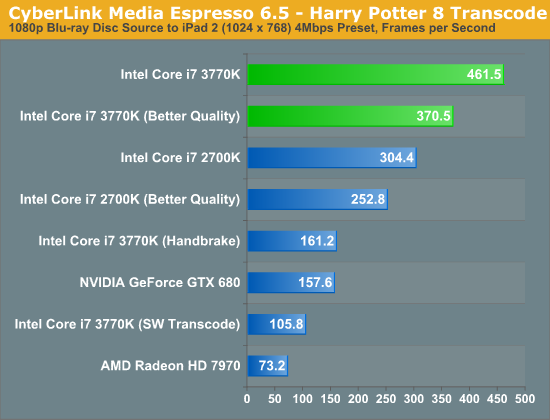
Just as we saw with Sandy Bridge, Quick Sync continues to be an incredible way to get video content onto devices other than your PC. One thing I wanted to make sure of was that Media Espresso wasn't somehow holding x86 performance back to make the GPU accelerated transcodes seem much better than they actually are. I asked our resident video expert, Ganesh, to clone Media Espresso's settings in a Handbrake profile. We took the profile and performed the same transcode, the result is listed above as the Core i7 3770K (Handbrake). You will notice that the Handbrake x86/x264 path is definitely faster than Cyberlink's software path, by over 50% to be exact. However even using Handbrake as a reference, Quick Sync transcodes over 2x faster.
In the tests below I took the same source and varied the output quality with some custom profiles. I targeted 1080p, 720p and 480p at decreasing average bitrates to illustrate the relationship between compression demands and performance:
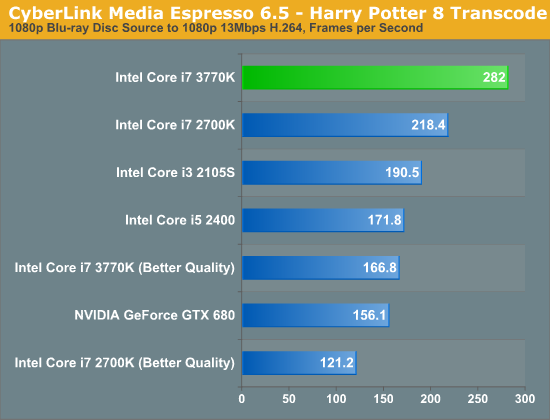
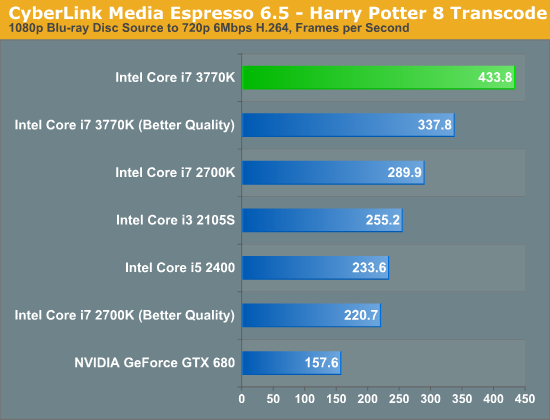

Unfortunately NVENC performance does not scale like Quick Sync. When asked to preserve a good amount of data, both NVENC and Quick Sync perform similarly in our 1080p/13Mbps test. However ask for more aggressive compression ratios for lower resolution/bitrate targets, and the Intel solution quickly distances itself from NVIDIA. One theory is that NVIDIA's entropy encode block could be the limiting factor here.
Ivy Bridge's improved Quick Sync appears to be aided both by an improved decoder and the HD 4000's faster/larger EU array. The graph below helps illustrate:
If we rely on software decoding but use Intel's hardware encode engine, Ivy Bridge is 18% faster than Sandy Bridge in this test (1080p 13Mbps output from BD source, same as above). If we turn on both hardware decode and encode, the advantage grows to 29%. More than half of the performance advantage in this case is due to the faster decode engine on Ivy Bridge.


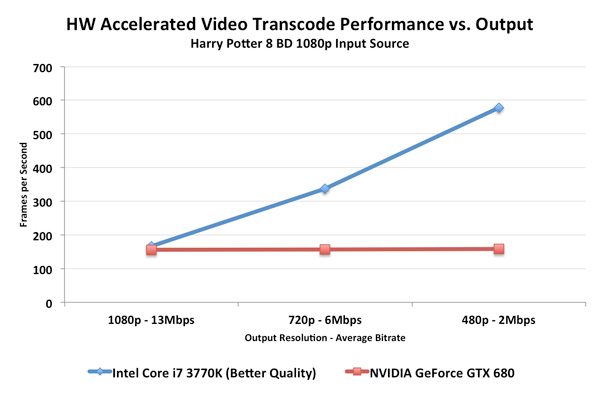
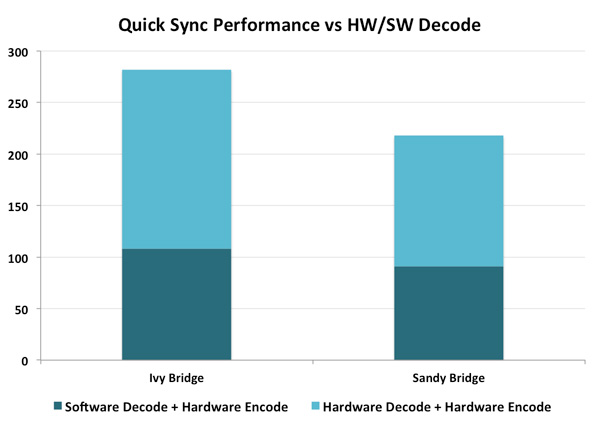








173 Comments
View All Comments
cjb110 - Tuesday, April 24, 2012 - link
Considering that on most games both the Xbox and PS 3tend to be sub 720p, the iGPU in Ivy Bridge is impressive. Has anybody compared the 3?tipoo - Tuesday, April 24, 2012 - link
You have a unified shader GPU with similar performance to the x1900 series but more flexible, and something like a Geforce 7800 with some parts of the 7600 like lower ROPs and memory bandwidth...7 years later, if even an IGP didn't beat those, it would be pretty sad. Those were ~200gflop cards, todays top end is over 3000, a lower-mid range chip like this I would expect to be in the upper hundreds.gammaray - Tuesday, April 24, 2012 - link
Why do Intel and AMD even started building IGPs in the first place?Why can't they just put a video card in every desktop and laptop?
And if they continue making IGPs, whats their goal?
Do they eventually wanna get rid of video card makers?
versesuvius - Tuesday, April 24, 2012 - link
Better yet, why not just put the graphics on a chip like the CPU? That way the "upgrade path" is a lot clearer, not to mention "possible". It will also offer the possibility of having those chips in different flavors, for example good video transcoder or good gamer. There is room for that on the motherboard now that the north bridge is gone. Or they can review the IBM boards from 286 days and learn from their clean, and very efficient design.Unfortunately the financial model of the IT industry from a collective viewpoint entails throwing a lot of good hardware away just for a small advantage. Just the way many will throw away their HD3000 IGPs without having ever used it. The comparison is cruel but that should not be what distinguishes them from the toilet paper industry.
As of late, Anand has taken to reminding us that technology has taken leaps ahead of our wishes and that we need time to absorb it. That is not the case. No wish is ever materialized. We only have to take whatever is offered and marvel at the only parameter that can be measured: speed. Less energy consumption is fine, but I suppose that comes with the territory (i.e. can Intel or AMD produce 22 nm chips that consume the same watts as 65 nm chips with the same number of transistors?).
tipoo - Wednesday, April 25, 2012 - link
Cost, size, power draw. All reduced by putting everything on one chip. I'm not sure if AMD wants to get rid of discreet graphics cards considering that's their one profitable division, but Intel sure does :)klmccaughey - Tuesday, April 24, 2012 - link
I've tried every setup possible and have never got quicksync to work at all. It won't even work with discrete graphics enabled and my monitor hooked up to the intel chip on my Z68 board.I have tried mediacoder (error 14), media converter 7, MEdia Espresso. I have downloaded the media SDK, I have tried the new FFmthingy from the intel engineer. Nothing, nada. It has never ever worked. AMD media converter will convert a few limited formats that went out of fashion 5 years ago (of all my 1.5TB of video the only thing it would touch was old episodes of Becker).
All in all I have got nothing whatsoever from any video accelerated encoding and I have always had to go back to my tried and trusted handbrake.
I don't think it actually works - I've never heard of anyone getting it working and the forums on mediacoder are full of people who have given up.
klmccaughey - Tuesday, April 24, 2012 - link
*disabled (for discrete graphics)JarredWalton - Tuesday, April 24, 2012 - link
What input format are you using? I've only tried it on laptops, and I've done MOV input from my Nikon D3100 camera with no issues whatsoever. I've also done a WMV input file (the sample Wildlife.WMV file from Windows 7) and it didn't have any trouble. If you're trying to do a larger video, that might be an issue, or it might just be a problem with the codec used on the original video.dealcorn - Tuesday, April 24, 2012 - link
Intel has big eyes for the workstation graphics market and has had some success at the bottom of this market. Will IB's IGD advances enhance Intel's access to this market?chizow - Tuesday, April 24, 2012 - link
Hope you're not counting yourself, you've proven long ago your opinion isn't worth paying attention to.